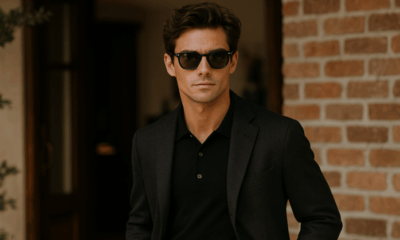Life
How to Use the “12 Week Year” to Supercharge Your Productivity
The “12 Week Year” is a method designed to accelerate your success by changing how you think about time

The “12 Week Year” created by Brian P. Moran and Michael Lennington condenses yearly goals into 12-week periods. This method is meant to increase urgency and clarity, pushing you to get more done in less time.
Traditional annual goals often lead to procrastination because those December deadlines are so far in the future. However, the “12 Week Year” keeps you constantly engaged by shortening the cycle.
This article will explain how to use the “12 Week Year” to supercharge your productivity by transforming both your personal and professional goals with focused execution in each quarter.
Understanding the “12 Week Year”
The “12 Week Year” is a method designed to accelerate your success by changing how you think about time. Instead of a typical year-long outlook, this approach breaks down your year into four quarters, each consisting of 12 weeks.
By doing so, it creates shorter execution cycles, which are crucial for increasing productivity and getting you results faster.
Core Principles
The “12 Week Year” is built on three important pillars:
- Urgency: The shortened time frame creates a sense of urgency. Without the luxury of procrastination, you’re forced to act more decisively and consistently.
- Clarity: Setting goals for just 12 weeks makes sure you are specific about what you want to achieve. This clarity simplifies decision-making and focuses your efforts on what’s actually important to your goal.
- Feedback: Rapid cycles allow for quicker feedback on your strategies and outcomes. This frequent reassessment helps you to stay aligned with your goals and make necessary adjustments fast.
Benefits Over Traditional Planning
Switching to a 12 week cycle offers several advantages over yearly planning:
- Increased Productivity: With the end always in sight, you’re more likely to stay energized.
- Better Focus: Shorter cycles mean less time for distractions so you can focus on the tasks that will move the needle.
- Faster Achievement: You can experience the satisfaction of achieving goals and leveraging those successes to fuel further accomplishments within the same year.
Planning Your 12 Week Year
This section will guide you through the process of creating a plan that is not only actionable but also aligned with your goals.
Step-by-Step Planning Process
- Define Clear Objectives: Start by figuring out what you want to achieve by the end of the 12 weeks. Your goals should be specific, measurable, achievable, relevant, and time-bound (SMART).
- Break Down Major Goals into Tasks: Divide each goal into smaller, manageable tasks that can be completed on a weekly or even daily basis. This breakdown makes the goal less daunting and easier to manage.
- Prioritize Tasks: Arrange your tasks by priority, focusing first on the ones that will have the greatest impact on your goals.
- Assign Deadlines and Milestones: Set deadlines for each task and establish milestones so you can review and celebrate your progress.
“Productivity is never an accident. It is always the result of a commitment to excellence, intelligent planning, and focused effort.” – Paul J. Meyer
Example: Opening a New Tattoo Studio
Let’s say you are entrepreneur with the goal of opening a brick and mortar shop like a tattoo studio in 12 weeks. Here’s an example of what you might want to do each week:
- Week 1: Do market research and develop a business plan.
- Week 2: Conduct surveys to understand customer demand and finalize financial projections.
- Week 3: Find potential shop locations.
- Week 4: Negotiate and sign a lease for your studio space.
- Week 5: Plan your studio’s layout and hire contractors for any plumbing, electrical, etc. issues.
- Week 6: Begin renovations .
- Week 7: Prepare all licensing and legal compliance paperwork.
- Week 8: Get your business licenses and schedule a health inspection with the local health department.
- Week 9: Interview and hire tattoo artists and someone to work the front desk.
- Week 10: Develop and execute a marketing plan.
- Week 11: Prepare for your Grand Opening and generate buzz with ads and social media posts.
- Week 12: Host a grand opening Flash Day event.
You would then further break down each of these weekly goals into small steps so you know what to do each day of the week to achieve that week’s objective.
By breaking down the goal into these detailed, time-specific tasks, you can manage each step effectively, making the daunting task of opening a new studio feel more doable.
Tracking Progress, Accountability, and Learning from Each Cycle
Regularly reviewing progress—daily, weekly, and at the end of each 12-week period—helps make sure you stay on track and can make changes to your plan, when necessary. Using progress charts or digital trackers can also make it easier to stay motivated as you work at a quick pace.
Also, having an accountability partner or joining a peer group can also help keep your motivation up.
If you do a “12 Week Year” multiple times, it’s important to review each “year” when you’re done. That way, you can figure out what worked, what didn’t, and how you can improve moving forward.
Learning from each cycle helps you make continuous improvement so that every 12-week period is more productive than the last one.
Final Thoughts
The “12 Week Year” transforms traditional goal-setting by dividing the year into intensive 12-week cycles to increase focus, urgency, and productivity. Each cycle encourages continuous growth, allowing for rapid adjustments and immediate results.
Adopt this strategy to be as productive as possible so that each quarter, you can take big steps forward and make real progress toward your goals.
Did You Know
How Skilled Migrants Are Building Successful Careers After Moving Countries
Behind every successful skilled migrant career is a mix of resilience, strategy, and navigating systems built for locals.

Moving to a new country for work is exciting, but it can also be unnerving. Skilled migrants leave behind familiar systems, networks, and support to pursue better job opportunities and a better future for their families. (more…)
Life
10 Research-Backed Steps to Create Real Change This New Year
This New Year could finally be the one where you break old patterns and create real, lasting change.

Every New Year, we make plans and set goals, but often repeat old patterns. (more…)
Life
9 Harsh Truths Every Young Man Must Face to Succeed in the Modern World
Before chasing success, every young man needs to face these 9 brutal realities shaping masculinity in the modern world.

Many young men today quietly battle depression, loneliness, and a sense of confusion about who they’re meant to be.
Some blame the lack of deep friendships or romantic relationships. Others feel lost in a digital world that often labels traditional masculinity as “toxic.”
But the truth is this: becoming a man in the modern age takes more than just surviving. It takes resilience, direction, and a willingness to grow even when no one’s watching.
Success doesn’t arrive by accident or luck. It’s built on discipline, sacrifice, and consistency.
Here are 9 harsh truths every young man should know if he wants to thrive, not just survive, in the digital age.
1. Never Use Your Illness as an Excuse
As Dr. Jordan B. Peterson often says, successful people don’t complain; they act.
Your illness, hardship, or struggle shouldn’t define your limits; it should define your motivation. Rest when you must, but always get back up and keep building your dreams. Motivation doesn’t appear magically. It comes after you take action.
Here are five key lessons I’ve learned from Dr. Peterson:
-
Learn to write clearly; clarity of thought makes you dangerous.
-
Read quality literature in your free time.
-
Nurture a strong relationship with your family.
-
Share your ideas publicly; your voice matters.
-
Become a “monster”, powerful, but disciplined enough to control it.
The best leaders and thinkers are grounded. They welcome criticism, adapt quickly, and keep moving forward no matter what.
2. You Can’t Please Everyone And That’s Okay
You don’t need a crowd of people to feel fulfilled. You need a few friends who genuinely accept you for who you are.
If your circle doesn’t bring out your best, it’s okay to walk away. Solitude can be a powerful teacher. It gives you space to understand what you truly want from life. Remember, successful men aren’t people-pleasers; they’re purpose-driven.
3. You Can Control the Process, Not the Outcome
Especially in creative work, writing, business, or content creation, you control effort, not results.
You might publish two articles a day, but you can’t dictate which one will go viral. Focus on mastery, not metrics. Many great writers toiled for years in obscurity before anyone noticed them. Rejection, criticism, and indifference are all part of the path.
The best creators focus on storytelling, not applause.
4. Rejection Is Never Personal
Rejection doesn’t mean you’re unworthy. It simply means your offer, idea, or timing didn’t align.
Every successful person has faced rejection repeatedly. What separates them is persistence and perspective. They see rejection as feedback, not failure. The faster you learn that truth, the faster you’ll grow.
5. Women Value Comfort and Security
Understanding women requires maturity and empathy.
Through books, lectures, and personal growth, I’ve learned that most women desire a man who is grounded, intelligent, confident, emotionally stable, and consistent. Some want humor, others intellect, but nearly all want to feel safe and supported.
Instead of chasing attention, work on self-improvement. Build competence and confidence, and the rest will follow naturally.
6. There’s No Such Thing as Failure, Only Lessons
A powerful lesson from Neuro-Linguistic Programming: failure only exists when you stop trying.
Every mistake brings data. Every setback builds wisdom. The most successful men aren’t fearless. They’ve simply learned to act despite fear.
Be proud of your scars. They’re proof you were brave enough to try.
7. Public Speaking Is an Art Form
Public speaking is one of the most valuable and underrated skills a man can master.
It’s not about perfection; it’s about connection. The best speakers tell stories, inspire confidence, and make people feel seen. They research deeply, speak honestly, and practice relentlessly.
If you can speak well, you can lead, sell, teach, and inspire. Start small, practice at work, in class, or even in front of a mirror, and watch your confidence skyrocket.
8. Teaching Is Leadership in Disguise
Great teachers are not just knowledgeable. They’re brave, compassionate, and disciplined.
Teaching forces you to articulate what you know, and in doing so, you master it at a deeper level. Whether you’re mentoring a peer, leading a team, or sharing insights online, teaching refines your purpose.
Lifelong learners become lifelong leaders.
9. Study Human Nature to Achieve Your Dreams
One of the toughest lessons to accept: most people are self-interested.
That’s not cynicism, it’s human nature. Understanding this helps you navigate relationships, business, and communication more effectively.
Everyone has a darker side, but successful people learn to channel theirs productively into discipline, creativity, and drive.
Psychology isn’t just theory; it’s a toolkit. Learn how people think, act, and decide, and you’ll know how to lead them, influence them, and even understand yourself better.
Final Thoughts
The digital age offers endless opportunities, but only to those who are willing to take responsibility, confront discomfort, and keep improving.
Becoming a man today means embracing the hard truths most avoid.
Because at the end of the day, success isn’t about luck. It’s about who you become when life tests you the most.
Change Your Mindset
The Four Types of Happiness: Which One Are You Living In?
Most people chase success only to find emptiness, this model reveals why true happiness lies somewhere else.

In a world driven by rapid technological growth and constant competition, many people unknowingly trade joy for achievement. (more…)
-

 Entrepreneurs4 weeks ago
Entrepreneurs4 weeks agoThe Essential Skills Every Entrepreneur Needs In 2026
-

 Change Your Mindset3 weeks ago
Change Your Mindset3 weeks agoHow to Turn Your Mind Into Your Greatest Asset (Instead of Your Enemy)
-

 Change Your Mindset3 weeks ago
Change Your Mindset3 weeks agoThe Silent Skill That Makes People Respect You Instantly
-

 Life2 weeks ago
Life2 weeks ago10 Research-Backed Steps to Create Real Change This New Year
-

 Tech2 weeks ago
Tech2 weeks agoWhat’s in a Name? How to Get Your Domain Right
-

 Did You Know2 weeks ago
Did You Know2 weeks agoHow Skilled Migrants Are Building Successful Careers After Moving Countries
























